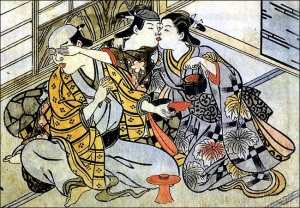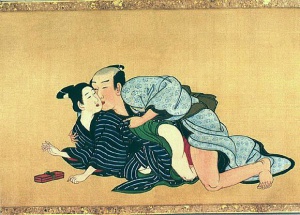(Boylove Documentary Sourcebook) - Bisexuality in an Episode of 'Kitayama Cherry-Blossoms of Narukami and Fudō' by Tsuuchi Hanjurō, Yasuda Abun and Nakada Mansuke: Difference between revisions
Dandelion moved page (BLSB) - Bisexuality in an Episode of 'Kitayama Cherry-Blossoms of Narukami and Fudō' by Tsuuchi Hanjurō, Yasuda Abun and Nakada Mansuke to [[(BLSB) - Bisexuality in an Episode of 'Narukami Fudō Kitayama Zakura' by Tsuuchi H... |
Replaced the redirect code with the new content of the page |
||
| Line 1: | Line 1: | ||
[[File:Japanesepederasty18thcentury.jpg|thumb|center|18th-century Japanese print of a man with his young male lover sneaking a kiss with a female prostitute, by Nishikawa Sukenobu.]] | |||
From <i>Male Colors: The Construction of Homosexuality in Tokugawa [[Japan]]</i> by Gary P. Leupp (Berkeley: University of California Press, 1995). Footnote omitted. | |||
<b>Note:</b> <i>At the time the play in question was written, Japan followed the East Asian age reckoning, by which a person is considered to be one year old at birth.</i><ref>https://en.wikipedia.org/wiki/East_Asian_age_reckoning</ref> | |||
<div style="margin:.5em auto; width:95%; min-height:5em; background-color:#F5FAFF; border:3px solid #c9c9ff; padding:1em;"> | |||
One episode in the kabuki play <i>Narukami Fudō Kitayama zakura</i> (Kitayama cherry-blossoms of Narukami and Fudō, 1742), by Tsuuchi Hanjurō, Yasuda Abun, and Nakada Mansuke, nicely illustrates the [[Bisexuality|bisexual]] tastes expected of the robustly amorous, swashbuckling <i>rōnin</i> (masterless [[samurai]]). The hero, Danjirō, lingers in an antechamber awaiting an audience with a lord. Retainers of the household come to attend him. First Hidetarō, a delicate boy of twelve or thirteen, enters to offer him tobacco. A delighted Danjirō compliments him on his beauty and asks about the progress of his martial training. The boy replies that he has been studying archery but has not yet learned to ride a horse. | |||
Danjirō thereupon offers to instruct Hidetarō in horseback riding. When the boy enthusiastically accepts the offer, the stalwart squeezes the boy between his thighs, explaining, “Press tightly against the flanks of your mount, thus.” | |||
Embracing the boy, he rocks him back and forth suggestively, but when he attempts a kiss, Hidetarō panics and runs off. Danjirō laughs, bows to the audience, and facetiously pronounces his own conduct “shameful.” | |||
Next a woman of the house arrives with tea. Danjirō badgers her as well, making several vulgar jokes that play on the slang use of the term “tea” to refer to sex with a prostitute. She, too, abandons him in disgust while he faces the audience and quips, “That’s two cups of tea I’ve been denied!” | |||
Clearly, this samurai hero is equally amenable to having sex with boys or with women. So too, apparently, were many commoners, particularly the young libertines glamorized in much of Tokugawa popular literature. | |||
</div> | |||
[[File:Miyagawa Isshô-Spring Pastimes-C.jpg|thumb|center|Scene on a panel from the <i>Spring Pastimes</i> series (ca. 1750) by Miyagawa Isshō. <i>[[Nanshoku]]</i>-type tryst between a samurai and a boyfriend. [[Homoerotic (dictionary)|Homoerotic]] <i>shunga</i> hand scroll (<i>kakemono-e</i>); <i>sumi</i>, color and <i>gofun</i> on silk. Private collection.]] | |||
==References== | |||
{{reflist}} | |||
==See also== | |||
*[[Chigo]] | |||
*[[Chigo monogatari]] | |||
*[[Pederasty]] | |||
*[[Shudō]] | |||
*[[The Great Mirror of Male Love (book)]] | |||
*[[Wakashū]] | |||
==External Links== | |||
*[http://greek-love.com/far-east/japan/the-age-of-the-loved-boy-in-japan-pederasty THE AGE OF THE LOVED BOY IN TRADITIONAL JAPAN (Greek Love Through the Ages)] | |||
[[Category:Boylove Sourcebook]] | |||
[[Category:Japanese literature]] | |||
[[Category:LGBT articles]] | |||
Revision as of 20:52, 5 April 2019

From Male Colors: The Construction of Homosexuality in Tokugawa Japan by Gary P. Leupp (Berkeley: University of California Press, 1995). Footnote omitted.
Note: At the time the play in question was written, Japan followed the East Asian age reckoning, by which a person is considered to be one year old at birth.[1]
One episode in the kabuki play Narukami Fudō Kitayama zakura (Kitayama cherry-blossoms of Narukami and Fudō, 1742), by Tsuuchi Hanjurō, Yasuda Abun, and Nakada Mansuke, nicely illustrates the bisexual tastes expected of the robustly amorous, swashbuckling rōnin (masterless samurai). The hero, Danjirō, lingers in an antechamber awaiting an audience with a lord. Retainers of the household come to attend him. First Hidetarō, a delicate boy of twelve or thirteen, enters to offer him tobacco. A delighted Danjirō compliments him on his beauty and asks about the progress of his martial training. The boy replies that he has been studying archery but has not yet learned to ride a horse.
Danjirō thereupon offers to instruct Hidetarō in horseback riding. When the boy enthusiastically accepts the offer, the stalwart squeezes the boy between his thighs, explaining, “Press tightly against the flanks of your mount, thus.” Embracing the boy, he rocks him back and forth suggestively, but when he attempts a kiss, Hidetarō panics and runs off. Danjirō laughs, bows to the audience, and facetiously pronounces his own conduct “shameful.”
Next a woman of the house arrives with tea. Danjirō badgers her as well, making several vulgar jokes that play on the slang use of the term “tea” to refer to sex with a prostitute. She, too, abandons him in disgust while he faces the audience and quips, “That’s two cups of tea I’ve been denied!”
Clearly, this samurai hero is equally amenable to having sex with boys or with women. So too, apparently, were many commoners, particularly the young libertines glamorized in much of Tokugawa popular literature.
